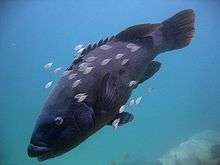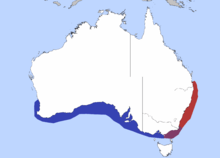Achoerodus viridis
The eastern blue groper (Achoerodus viridian) is a species of wrasse native to southeastern Australia from Hervey Bay in southern Queensland to Wilsons Promontory in Victoria.[3] They occur in coastal waters, preferring rocky areas at a depth of about 40 m (130 ft).[2] Juveniles inhabit beds of seagrass in estuaries. The diet of this species consists of invertebrates such as various molluscs, crabs, sea urchins, and cunjevoi.[3] This species grows to a length of 72 cm (28 in) as adult males, while females are less than 60 cm (24 in) long. This species was sometimes sought as a game fish but this is now banned in New South Wales. In 1998, the eastern blue groper was made the state fish emblem of New South Wales.[4]
| Achoerodus viridis | |
|---|---|
 | |
| Scientific classification | |
| Kingdom: | Animalia |
| Phylum: | Chordata |
| Class: | Actinopterygii |
| Order: | Labriformes |
| Family: | Labridae |
| Genus: | Achoerodus |
| Species: | A. viridis |
| Binomial name | |
| Achoerodus viridis (Steindachner, 1866) | |
 | |
| Red = Eastern blue groper | |
| Synonyms[2] | |
Distribution and habitat
The eastern blue groper is native to the southeastern coast of Australia. Its range extends from Mooloolaba in southern Queensland southwards to Wilsons Promontory in the south of Victoria, including the eastern end of the Bass Strait.[1] Its habitat is rocky areas down to a depth of about 40 m (131 ft).[2]
Behaviour
The eastern blue groper feeds mainly on crabs, shrimps, molluscs and echinoderms. Juvenile fish live in seagrass beds where their diet is primarily small crustaceans. This fish is a sequential hermaphrodite, starting life as a female and becoming a male when it has reached a length of at least 60 cm (24 in). The fish become sexually mature at age two to three and breeding takes place between July and September. The larvae are planktonic at first and settle in seagrass beds.[1]
Status
The total range of this fish extends to less than 64,000 km2 (25,000 sq mi). It is a slow-growing, long-lived fish and the generation turnover time is approximately twelve to fifteen years. At one time the population was dwindling because of excessive spear fishing, but in 1972, the New South Wales authorities put a ban in place, preventing all spear fishing and commercial fishing for this species. Its population size since then seems to have stabilised and the IUCN has listed it as being "Near Threatened".[1]
References
- Choat, J.H. & Pollard, D. (2010). "Achoerodus viridis". IUCN Red List of Threatened Species. 2010: e.T187572A8572139. doi:10.2305/IUCN.UK.2010-4.RLTS.T187572A8572139.en. Retrieved 25 December 2019.
- Froese, Rainer and Pauly, Daniel, eds. (2013). "Achoerodus viridis" in FishBase. August 2013 version.
- "Eastern Blue Groper". Fish'n'kids. New South Wales Department of Primary Industries. Archived from the original on 17 October 2006. Retrieved 11 November 2006.
- "Symbols & Emblems of NSW". Archived from the original on 2010-03-27. Retrieved 7 March 2010.
